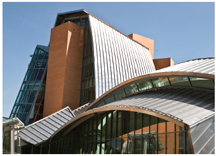
|
May 14, 2008: President's Page
THE ALUMNI WEEKLY PROVIDES THESE PAGES TO THE PRESIDENT
Princeton's new Lewis Science Library nears completion. (brian wilson) |
A Library for Scientists
This fall, Princeton's faculty and students will have a new—and spectacular—setting in which to explore the wonders of science, thanks to the exceptional generosity of University trustee Peter Lewis '55, the creativity of Pritzker Prize-winning architect Frank Gehry, and the leadership of project manager Henry Thomas and his colleagues. The Lewis Science Library that is nearing completion at the corner of Washington Road and Ivy Lane will form the hub of our emerging science neighborhood and, for the first time since the 19th century, will bring our scientific books, periodicals, maps, and other scholarly resources together in one place.
Like his celebrated Guggenheim Museum in Bilbao, there is nothing prosaic about the postmodern 87,000-square-foot structure that Mr. Gehry has designed for us. More sculpture than building, it is impossible not to marvel at its curving lines, its merging of roof and wall, its bold embrace of color, and its unconventional marriage of stainless steel and brick. Its four above-ground floors reach a height of 103 feet, complementing nearby Fine Tower, yet its innovative massing also links it to its low-rise neighbors. An abundance of glass—from windows to curtain walls to clerestories—echoes the day when libraries were forced to depend on natural light for illumination. Indeed, there is a wonderful lightness—even playfulness—to the Lewis Library. While its design may strike some as a stunning departure from past architectural styles on our campus, its placement on Washington Road is consistent with the contemporary architecture of neighboring buildings such as Robertson Hall and Icahn Laboratory.
I will not attempt to fully describe the Lewis Library's interior, other than to say that each floor is unique, with spaces of every conceivable size and shape. My favorite spot is the second-floor "tree house," a spacious glass-walled reading room in which pendant lights look down on comfortable seating. The canopies of nearby trees create the illusion of a treetop retreat, and I predict that this reading room will become one of the most popular study spaces on campus.
The opening of the Lewis Library will have an immediate and powerful impact on the natural sciences at Princeton and will symbolize the increasingly interdisciplinary nature of the work in these fields on our campus. The sciences at Princeton have long been served by small departmental libraries, which created considerable redundancies in our collections, not to mention frustration among students and faculty whose work increasingly crosses disciplinary boundaries. Today, it makes neither fiscal nor academic sense to have a math and physics library in Fine Hall and an astrophysics library in Peyton Hall, to cite but one example of the problem that the Lewis Library will solve.
And so, after many years of isolation, these two libraries, along with geosciences, biology, chemistry, and psychology, are moving in stages to the Lewis Library, which will connect to the library in Fine Hall via an underground tunnel. The collections (some 150,000 volumes) will be completely integrated on compact shelving units, eliminating duplication, and librarians will be able to offer instructional programs on a scale impossible when they were widely scattered. In the same spirit, the central information desk will offer one-stop shopping, as reference, circulation, document delivery, and other services are consolidated. And the third and fourth floors, with their inviting mix of carrels, tables, soft seating, and group study rooms, are designed to encourage interaction, as well as solitary study, for the Lewis Library is as much about bringing faculty and students from many disciplines together as it is about consolidating holdings.
Princeton's newest library also underscores the growing importance of computational
tools and digital information in the sciences, from DNA sequencing to geological
mapping. Its electronic classroom, numerous computer clusters, and wireless environment
will allow our faculty and students to take full advantage of the online world,
aided by librarians with subject specialties. The importance of computing today
is also evident in the fact that the Lewis Library will have a number of other
occupants. In addition to several all-purpose classrooms, it will become the
epicenter of Princeton's campus-wide instructional and research technology activities,
creating a spacious home for the Educational Technologies Center and New Media
Center, which are helping faculty and students to incorporate digital resources
in their work. It will also house Princeton's first Broadcast Center, which includes
a fully equipped video and audio studio, and the Princeton Institute for Computational
Science and Engineering (PICSciE) and the Computational Science and Engineering
Support Group, which support the field of high-performance computing. There is
no doubt in my mind that the Lewis Science Library, like Peter's other gifts
to Princeton, will significantly strengthen the effectiveness of the University,
and enable our faculty and students to realize their full potential to make the
world a better place through advances in scientific understanding. ![]()


